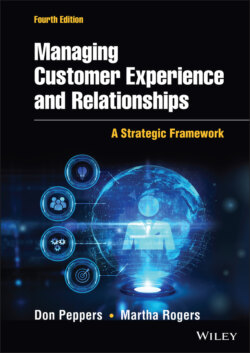Читать книгу Managing Customer Experience and Relationships - Don Peppers - Страница 27
THE STRATEGY: TREAT DIFFERENT CUSTOMERS DIFFERENTLY (TDCD)
ОглавлениеManaging customer relationships effectively is a practice not limited to products. When establishing interactive Learning Relationships with valuable customers, customer-strategy enterprises remember a customer's specific needs for the basic product but also the goods, services, and communications that surround the product, such as how the customer would prefer to be invoiced or how the product should be packaged. Even an enterprise that sells a commodity-like product or service can think of it as a bundle of ancillary services, delivery times, invoicing schedules, personalized reminders and updates, and other features that are rarely commodities. The key is for the enterprise to focus on customizing to each individual customer's needs. A teenager in California received a text from her wireless phone service suggesting her parents could save money if she texted “4040” in an offer to switch her to a cell phone plan that was a better fit for her and the way she actually uses the service. She was so impressed she made a point of telling us about it. And of course, she told all her friends at school—and on TikTok, Snapchat, and Instagram. The coverage, the hardware, the central customer service, and the brand all remained the same. But the customer experience, based on actual usage interaction with the customer—information not available to competitors—improved the customer relationship, increased loyalty and lifetime value of the customer, and positively influenced other customers as well.
As other chapters in this book will demonstrate, a customer-centric business strategy can be a highly measurable process for increasing enterprise profitability and shareholder value. The foundation for growing a profitable customer-strategy enterprise lies in establishing stronger relationships with individual customers, paving a path to profitability by focusing on the different experiences of individual customers and fostering stronger relationships with them over time. The challenge to be considered throughout this text is understanding how best to establish these relationships, optimize them, and create more value from customers. Learning Relationships provide a ready path for generating long-term, competitively strong customer value.
But we need to have a stronger understanding of the specific qualities that underlie a better customer experience, and why these qualities are likely to create value for the customer-strategy enterprise.
When a customer teaches an enterprise what they want or how they want it, the customer and the enterprise are, in essence, collaborating on the sale of the product. The more the customer teaches the enterprise, the less likely the customer will want to leave. The key is to design products, services, and communications that customers value, and on which a customer and a marketer will have to collaborate for the customer to receive the product, service, or benefit.
Enterprises that build Learning Relationships clear a wider path to customer profitability than companies that focus on price-driven transactions. They move from a make-to-forecast business model to a make-to-order model, as Dell Computer did when it first created a company that reduced inventory levels by building each computer after it was paid for, using efficient mass customization technology. By focusing on gathering information about individual customers and using that information to customize communications, products, and services, enterprises can more accurately predict inventory and production levels. Fewer orders may be lost because mass customization can build the products on demand and thus make available to a given customer products that cannot be stocked ad infinitum. (We will discuss customization further in Chapter 10.) Inventory-less distribution from a made-to-order business model can prevent shortages caused in distribution channels as well as reduce inventory carrying costs. The result is fewer opportunity losses. Furthermore, efficient mass-customization operations can ship built-to-order custom products faster than competitors that have to customize products from scratch.3 In many ways, economies of scale have been replaced by economies of scope.4
Enterprises that build Learning Relationships clear a wider path to customer profitability than companies that focus on price-driven transactions.
Learning Relationships have less to do with creating a fondness on the part of a customer for a particular product or brand and more to do with a company's capability to remember and deliver based on prior interactions with a customer. An enterprise that engages in a Learning Relationship creates a bond of value for the customer, a reason for an individual customer, or small groups of customers with similar needs, to lose interest in dealing with a competitor, provided that the enterprise continues to deliver a good-quality product and service at a fair price and to remember to act on the customer's preferences and tastes.5 Learning Relationships may also be based on an inherent trust between a customer and an enterprise. For example, a customer might divulge a credit card number to an organization, which records it and remembers it for future transactions. The customer trusts that the enterprise will keep this credit card number confidential. And the enterprise makes it easier and faster for the customer to buy because it is not necessary to reenter the credit card number for each purchase. (Later in the chapter, we'll learn more about the link between emotions and behavior in relationships.)
Learning Relationships have less to do with creating a fondness on the part of a customer for a particular product or brand and more to do with a company's capability to remember and deliver based on prior interactions with a customer.
